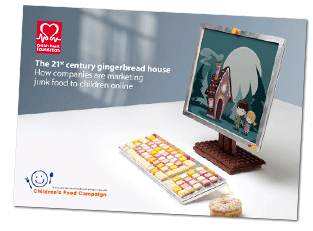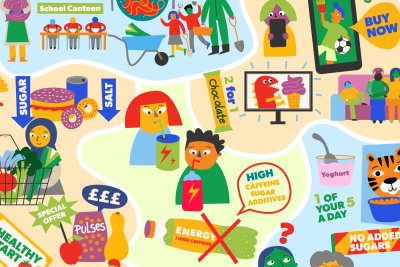News • Children's Food Campaign
Report exposes how junk food manufacturers prey on children online
Charities demand tighter online advertising regulations to protect kids health
 A new report released today by the Children’s Food Campaign (CFC) and the British Heart Foundation (BHF) reveals the manipulative tactics junk food manufacturers use to hook children while they play online and entice them to eat foods loaded with fat, salt and sugar (1). The charities are now calling for consistent advertising regulations across all forms of media to protect children and their future health.
A new report released today by the Children’s Food Campaign (CFC) and the British Heart Foundation (BHF) reveals the manipulative tactics junk food manufacturers use to hook children while they play online and entice them to eat foods loaded with fat, salt and sugar (1). The charities are now calling for consistent advertising regulations across all forms of media to protect children and their future health.
The report – The 21st century gingerbread house: How companies are marketing junk food to children online - assessed how junk food manufacturers bombard kids online in a bid to push unhealthy products. All the brands featured in the report are products high in fat, salt or sugar (HFSS) which are currently marketed to children online (2).
Advertisements for these products can’t be shown during children’s television programmes because they fail the Food Standards Agency and Ofcom nutrient profiling test (3). Yet due to a loophole in advertising regulations companies are allowed to market these products and brands freely via the internet.
Previous research has shown that marketing influences children’s food choices (4). We know that in the UK children’s diets tend to contain too much fat, salt and sugar (5), and this could have serious implications for future levels of heart disease and other life-threatening illnesses (6).
The key online tactics of food manufacturers include:
- Bespoke websites which appeal to children through the use of language intended for, spoken by or directly to children.
- Brand characters, cartoons and animations which are enormously popular with children.
- Free gifts including apps, downloads, ringtones and games of appeal to children.
- The use of social networking sites as a way to encourage children to share the brand with their friends.
The examples in the new report illustrate the ways HFSS products are promoted to children online – a practice it exposes as being widespread. (7)
The report comes at a time when internet usage amongst children is almost as high as television viewing (8). Eight in ten of all children (82%) are now using the internet at home rising to more than nine in ten in the 12-15 age group (93%) (9).
Charlie Powell, Campaigns Director for the Children’s Food Campaign, said:
“Companies are shamelessly exploiting gaps in marketing regulations by targeting children online with promotions for junk foods that cannot be advertised during children’s TV. By its failure to protect children from online junk food marketing, the Government is demonstrating complacency at a time when it should provide robust regulation to help reverse unacceptable levels of obesity in the UK.”
Mubeen Bhutta, Policy Manager at the BHF said:
“Like wolves in sheep’s clothing, junk food manufacturers are preying on children and targeting them with fun and games they know will hold their attention. Regulation protects our children from these cynical marketing tactics while they’re watching their favourite children’s TV programmes but there is no protection when they’re online. The marketeers must be rubbing their hands with glee because this loophole gives them carte blanche to reach eight in ten children behind their parents’ backs.
“With around a third of children classified as overweight or obese today it’s crucial that the UK Government takes action. We want to see consistent advertising regulations across all forms of media to protect our children from the lure of junk food marketing, and help protect their future health.”
To show how manipulative the tactics used by food manufacturers are, the BHF has launched an online experience called the ‘Five Steps to Junk Food Marketing Success’, featuring our fictional product, the ‘Lard Bar’. The Five Steps take users through the tactics used by junk food marketers to push their products. The BHF is urging supporters to email Jeremy Hunt, the Secretary of State for Culture, Olympics, Media and Sport calling for tighter regulations online.
The report is released as part of the BHF’s Food4Thought campaign which aims help to tackle childhood obesity. To find out more visit www.bhf.org.uk/junkfood.
For more information please call the BHF press office on 020 7554 0164 or 07764 290 381 (out of office hours) or email newsdesk@bhf.org.uk
Notes to editors
(1) Products are featured in the British Heart Foundation and Children’s Food Campaign report The 21st C. Gingerbread house: How companies are marketing junk food to children online. The report was conducted between April and July 2011. We identified 100 websites including product sites, brand sites and company web pages which we examined in detail.
The report can be downloaded from https://www.sustainweb.org/publications/?id=200
(2) All of the case studies featured in the report are products high in fat, salt and sugar – not all of the 100 products surveyed.
(3) Broadcasting code
The broadcasting code regulates food and drink advertising on television by identifying HFSS products. Products which do not meet specific nutritional criteria cannot be advertised during programmes or television channels made specifically for children, or during programmes of particular appeal to children under 16. The code also provides guidance to identify unhealthy brands and works to prevent the advertising of high fat, sugar and salt (HFSS) brands to children. Product placement for HFSS foods and drinks is prohibited in all broadcast advertising.
Online advertising
The Advertising Standards Authority (ASA) is an advertising industry body set up to apply voluntary codes of practice and avoid regulation. In 2011, the ASA extended its remit to include online advertising on paid for and non-paid for space, including company websites and social networking platforms. Unlike the television regulations, the non-broadcast code does not distinguish between healthy and unhealthy food. Instead it exists to ensure that advertising is ‘legal, decent, honest and truthful’, rather than to protect and promote health. Consequently, when it does touch on health issues, the wording of the code is vague. For example, it states that ‘marketing communications should not condone or encourage poor nutritional habits or an unhealthy lifestyle in children’ but what constitutes ‘condoning and encouraging’ or ‘poor habits’ is left open to interpretation. This means that companies can market HFSS products to children online which cannot be advertised during children’s television programmes.
(4) Independent, systematic and peer-reviewed research commissioned by the Food Standards Agency concluded that food promotion influences children’s behaviour in a number of ways – including their preferences, purchase behaviour and consumption. Hastings et al (2003) Review of the research on the effects of food promotion to children. Food Standards Agency.
(5) The 21st C. Gingerbread house: How companies are marketing junk food to children online pg.2. Children are eating too much sugar, fat and salt statistic taken from NDNS data 2000 & 2007.
(6) Obese children are more likely to become obese adults making them more vunerable to serious conditions which increase the risk of heart disease, stroke and some cancers. Whitaker, R.C. Wright, J.A. Pepe, M.S. et al (1997); Predicting obesity in young adulthood from childhood and parental obesity. The New England Journal of Medicine. 337: 869 – 73.
(7) Some of the brand tactics included in the report are:
Sugar Puffs ‘Find Honey Monster’
Sugar Puffs claim to be ‘packed with honey goodness’ yet one serving contains more sugar (10.6g) than a typical ring doughnut (9.2g) (7).The website uses a variety of tactics to get kids hooked. A young boy called Charlie hosts the site and invites users to help ‘Find Honey Monster’. Children are encouraged to upload photos and videos, play games and enter competitions.
Our tester signed up to the Honey Monster monthly newsletter and received emails every week over a three month period, and was encouraged to enter challenges and competitions. Users are asked to seek parental permission if they are under 16, but the advice to parents says consent is only needed for children under 12 years. The site can easily be accessed by a child of any age who simply ticks the parental consent ‘verify’ box.
One 30g serving of Sugar Puffs contains 10.6g sugar (www.honeymonster.co.uk).
One typical ring doughnut contains 9.2g sugar (FSA composition of foods tables with MAFF food portion sizes book for average serving)
Cheestrings ‘101 things to do before you’re 11.5’
Cheestrings are described as ‘ideal lunchbox snacks’ yet just one Cheestring contains more salt (0.4g) than a typical pack of ready salted crisps (0.3g) (8). Children visiting the site are personally addressed by Mr.Strings, and encouraged to read a list of 101 things they can do before they are eleven and a half years of age.. A selection of games and videos are available to choose from, encouraging kids to keep coming back for more. There is no age verification needed.
One Cheestring contains 0.4g salt (www.cheestrings.co.uk)
One packet of Sainsburys ready salted crisps contains 0.3g salt www.sainsburys.co.uk/groceries/index.jsp
Nesquik ‘Imagination station’
Nesquik claim that their powder turns milk into an ‘extra nutritious drink’. Yet one serving of chocolate Nesquik mixed with semi-skimmed milk has over 12g of added sugar – that’s the equivalent of three teaspoons in each glass (9).
The Nesquik website hosted by an animated bunny character is full of ‘family fun’ including a ‘Quicky Quiz’ to test children’s knowledge, a ‘make a spacesuit’ guide, and links to the Nesquik Facebook page. A large number of photos of children holding their ‘imagination station’ entries are also scattered across the website. There is no age verification requirement.
Three teaspoons of Nesquik served with 200ml semi-skimmed milk contains 22g sugar. www.nesquik.co.uk/#/products/ The Dairy Council UK website states that a 200ml glass of semi skimmed milk provides 9.7g of naturally occurring sugars which means that there are 12.3g of added sugars (from the Nesquik powder) in one serving. One rounded teaspoon is the equivalent of 4g.
Cadbury Buttons ‘Buttons Furry Tales’
Just one pack of Cadbury’s milk chocolate buttons contains twice as much saturated fat (6.2g) as a typical hamburger (3g) (10). Animated characters are featured across the site including one which can be customised to match a child’s name and features. There is also an area dedicated to games, puzzles, interactive paintings and activities. Children’s bespoke books can also be shared on Facebook and Twitter. Users are asked to show they’re over 18 but the site can easily be entered by anyone entering a false year of birth.
The report comes at a time when internet usage amongst children is almost as high as television viewing (11). Eight in ten of all children (82%) are now using the internet at home rising to more than nine in ten in the 12-15 age group (93%) (12).
One standard bag of Cadbury’s Dairy Milk buttons contains 6.2g saturated fat
http://nutrition.cadbury.co.uk/epages/Store.storefront/?ObjectPath=/Shops/NutriApp/Products/726465
One standard Mcdonalds hamburger contains 3g saturated fat.
http://www.mcdonalds.co.uk/food/beef/hamburger.mcdj?dnPos=-363
(8) Children aged 5-15 spend most time watching TV. For 12-15s the next most-used medium is the internet, while for 5-7s and 8-11s it is gaming pg.33. Ofcom, Children and Parents: Media use and attitudes report, published 25 October 2011.
(9) Eight in ten of all children aged 5-15 (82%) use the internet at home through a PC or laptop. 12-15s are now more likely to do so than in 2010 (93% vs. 88%) pg.18. Ofcom, Children and Parents: Media use and attitudes report, published 25 October 2011.
- The Children’s Food Campaign aims to improve young people’s health and well-being through better food – and food teaching – in schools and by protecting children from junk food marketing. We are supported by over 150 national organisations and co-ordinated by Sustain: the alliance for better food and farming. For more information see www.childrensfood.org.uk.
- The British Heart Foundation (BHF) is the nation’s heart charity, dedicated to saving lives through pioneering research, patient care, campaigning for change and by providing vital information. But we urgently need help. We rely on donations of time and money to continue our life-saving work. Because together we can beat heart disease. For more information visit www.bhf.org.uk
.
Published Sunday 18 December 2011
Children's Food Campaign: Better food and food teaching for children in schools, and protection of children from junk food marketing are the aims of Sustain's high-profile Children's Food Campaign. We also want clear food labelling that can be understood by everyone, including children.




